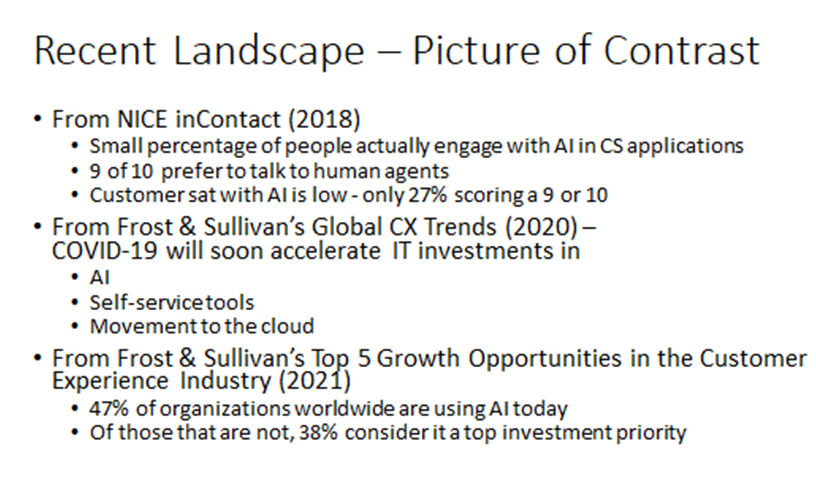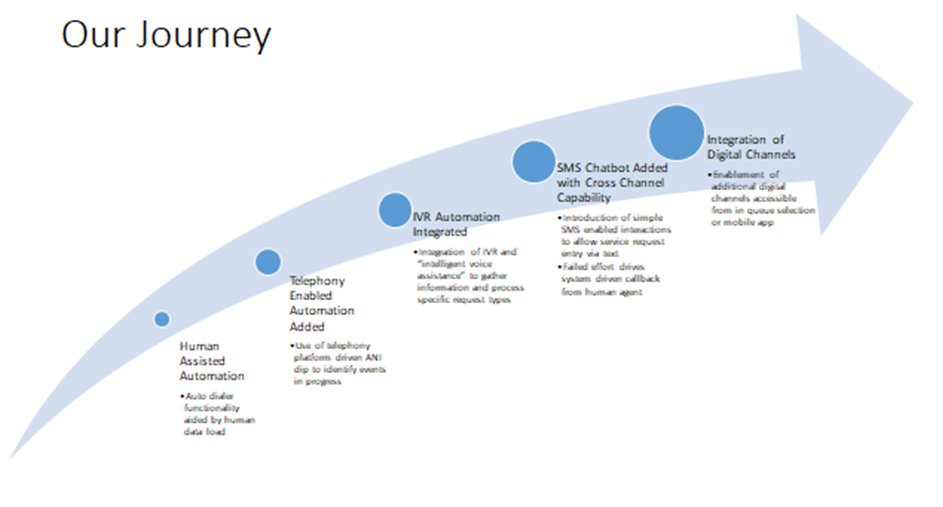Abstract
Self-service channels can have significant cost advantages, and even cross channel fallout can reduce employee effort, preserving savings. The design and implementation of these channels can prove less intuitive than we may initially perceive. This discussion examined real-world examples of design challenges and customer experiences to highlight the importance of the human element in self-serve channels.
Key Take-Aways
- Business rules affect design challenges and channel containment rates
- CX differentials between channel of choice and forced throughput
- AI assisted cost reduction can coexist with positive customer experience
- Metrics that matter
Overview
Joe Russo of AAA – The Auto Club Group shared his organization’s experiences implementing AI-driven self-service options to customers, including successes and lessons learned.
Where is your enterprise on the self-service journey and how are you measuring results?
Noting that he was a “fellow learner on the journey” Joe asked participants: How are you using and measuring success in self-service in your customer engagement strategy today? Member replies ranged from “we are just starting self-serve initiatives and have no strong metrics yet” to “we measure volume from the self-service channel plus other variables.” Other members elaborated further, stating, “For us, it’s a two-prong approach that includes telephone Interactive Voice Response (IVR) where customers self-serve. We measure containment and are still determining the best way to measure effectiveness.”
Another member shared that “they measure channel use and customer ease,” adding that, “as digital transformation grows, we see big differences in different market segments.” Another council member stated that their company was about halfway to where they wanted to be on their digital journey and were focused on connecting different systems and providing integrated end-to-end service. They generally measured success by how many customers could be successfully deflected. As noted, most consumers have come to expect some self-service options and many from the younger generation even prefer them.
The Recent, Rapid Rise of Self-Service
Joe Russo stated that, as recently as 2018, self-service was not big in the minds of consumers and in fact CSAT scores with self-service options were typically low. In the recent past, many customers even indicated on surveys that they preferred a human connection. But, as the graphic below illustrates, just a few years later, perhaps punctuated by the pandemic and an increasing shift to an online work-from-home lifestyle, self-service options have become much more popular. There is a big movement to offer self- service options as a part of the customer experience in many organizations today. As Joe noted, some organizations do self-service quite well, so well that it’s almost invisible in the IVR channel and many calls are resolved in two to three minutes maximum. Migration to the cloud, which facilitates better and more efficient data storage, has also contributed to the growing use of self-service technologies and the AI software that supports it.

AAA The Auto Club Group – Customer Self-Service Journey Insights
Joe discussed some key experiences and lessons learned from testing and implementing self-service functions at AAA in the last few years. He shared that an early initiative was creating a human-assisted automation piece, but noted difficulties syncing it to the telephone and dispatch system. Of course, in the case of at AAA The Auto Club Group, channels need to be synced to the emergency dispatch system. Listening to customer calls to better understand their journey and taking these learnings into account when designing the CX journey was a key recommendation. Doing so on an ongoing basis is also important.
Joe shared that his company recently added a self-service channel with SMS/texting capabilities and had experienced a good degree of success with it. He noted that the channel included a clear fail-over option to the phone; particularly important as AAA customers could be calling from the side of a road and might require immediate human assistance. Recently they implemented a mobile app and a web app, both also offer a failover function to a phone call with a human agent. The next major evolution at AAA will be a transition to new CRM software that will be integrated with the dispatch system, member records and other key departments. The goal is one clean data lake offering a 360 degree view of the customer, for the best experience possible. Below is a brief timeline of his organization’s customer experience journey with technology:

Member Q&A
As the presentation wrapped up, Joe fielded questions from the highly engaged group of industry colleagues:
Council Member questions included a discussion about using automated speech versus natural language – several participants admitted to having less than ideal experiences with automated speech and were migrating to natural language capabilities.
The complexities and challenges of identity verification and authorization were also addressed. For instance, in the case of AAA members, they have a 16-digit number to input; a hard process to make easy.
Council members also discussed the possible pros and cons of customer fallout while using self-service functions. As noted, fallout is not always a bad thing if there is a good reason, i.e., if the self-service functionality shortens the interaction overall and/or facilitates a satisfactory transaction or happy customer.
The overarching goal is to design an effective journey; there may be instances when business rules require customer fallout to avoid other issues.
The group also discussed CSAT surveys, specifically what to include in them, when to send them, and the best channel to communicate in. A brief 5-6 question email that is sent out soon after the customer experience and teases out agent satisfaction from transaction satisfaction, for example, seemed to bring the best results and response rates for the group.
A final key take-away to remember: “When customers choose the channel, they are usually happier.”



